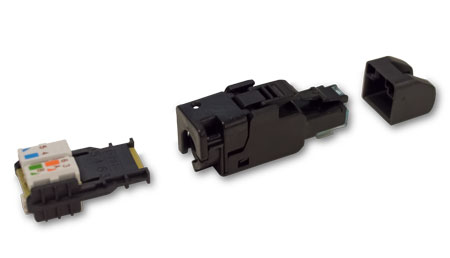Choose Your RJ45 Connection Wisely
Not So Fast!
Field crimping a plastic RJ45 plug on the end of a horizontal cable to directly connect to an IP camera or WAP (wireless application point) may seem like a great idea. After all, plastic plugs are very inexpensive. A horizontal cable and one plug seems like a very simple option, and installation always looks neat and clean.
But, if this is the route you choose to go, then buyer beware: It is a methodology riddled with pitfalls, headaches, and unexpected costs.

Field termination of plastic RJ45 plugs involves a complex crimping process that requires the steadiest of hands and priciest of tools. While the plugs are inexpensive, the proper crimp tools required can cost many hundreds of dollars. The crimping process is lengthy and difficult, and often requires extra time for rework and testing, which can slow you down. Accessory termination aids, such as load bars and wire guides, are available to make the process easier – but the costs of those aids begin to add up.
If this weren’t bad enough, there’s another factor to consider: If you crimp at the improper height, you can potentially damage the device, causing hundreds or potentially thousands of dollars in unexpected costs.
So is an indirect connection through modular jack assembly a better option? Terminating a jack on the end of the cable is a simple process, and installation is easier than with field termination of a plastic RJ45 plug. This method is compliant with standards, and overall performance is much more reliable. Required surface-mount boxes (or “biscuit boxes”) and patch cords are also inexpensive and widely available. Do these factors mean that an indirect connection through modular jack assembly is the way to go?
While it’s true that non-direct connections employing modular jack assembly and patch cords do meet the TIA 568-C.2 standard, there are some significant downsides to this method.
To start, finding a place to mount the box can lead to an install that doesn’t look clean or tidy. And while jacks, boxes, and patch cords aren’t too expensive individually, requiring all three for a non-direct connection can rack up costs – not to mention additional time to install and test. Finally, non-direct methods introduce a second potential point of failure. If your WAP goes down, how do you know whether it’s the patch cord or jack that needs to be replaced?
A Better Solution
The perfect connection must be out there somewhere – one that offers easy installation, high performance, and low fully installed costs. Yes, it does exist! Look no further than the mighty field mount plug.

Field mount plugs may be expensive individually, but that’s the extent of their downsides. There’s no need to purchase a jack, surface-mount box, or short patch cord; these plugs allow for direct connection into a device. The tools required for termination are commonly carried, inexpensive items, such as flush cutters and parallel pliers.
Installation of a field mount plug is highly reliable and fast (as quick as 60 seconds per plug)! Best of all, the performance of a field mount plug allows for guaranteed signal transmission for the highest-performing Category 6A applications. Field mount plugs even support PoE+ applications in accordance with IEEE 802.3at when a device requires power, such as a pan/tilt/zoom camera. As next-generation devices are introduced, the field mount plug will be the most reliable solution for Ethernet demands exceeding 1000BASE-T.
While different connection methods may seem attractive in the beginning, it’s important to take total cost of ownership into account. A field mount plug will provide the fastest installation, the highest performance, and the lowest total costs.
Belden is committed to offering products and solutions that save you time and money. We’re proud to preview the launch of our field mount plugs in July 2015. Please contact your local sales representative or schedule a call with one of our experts for more information.
